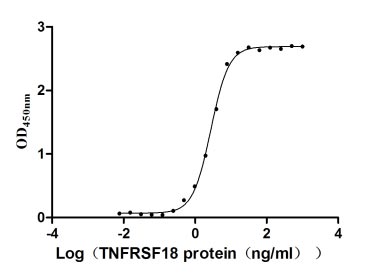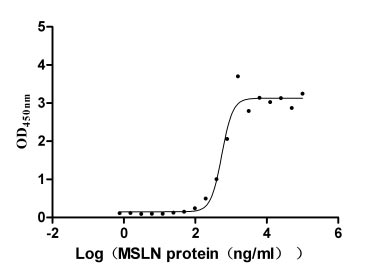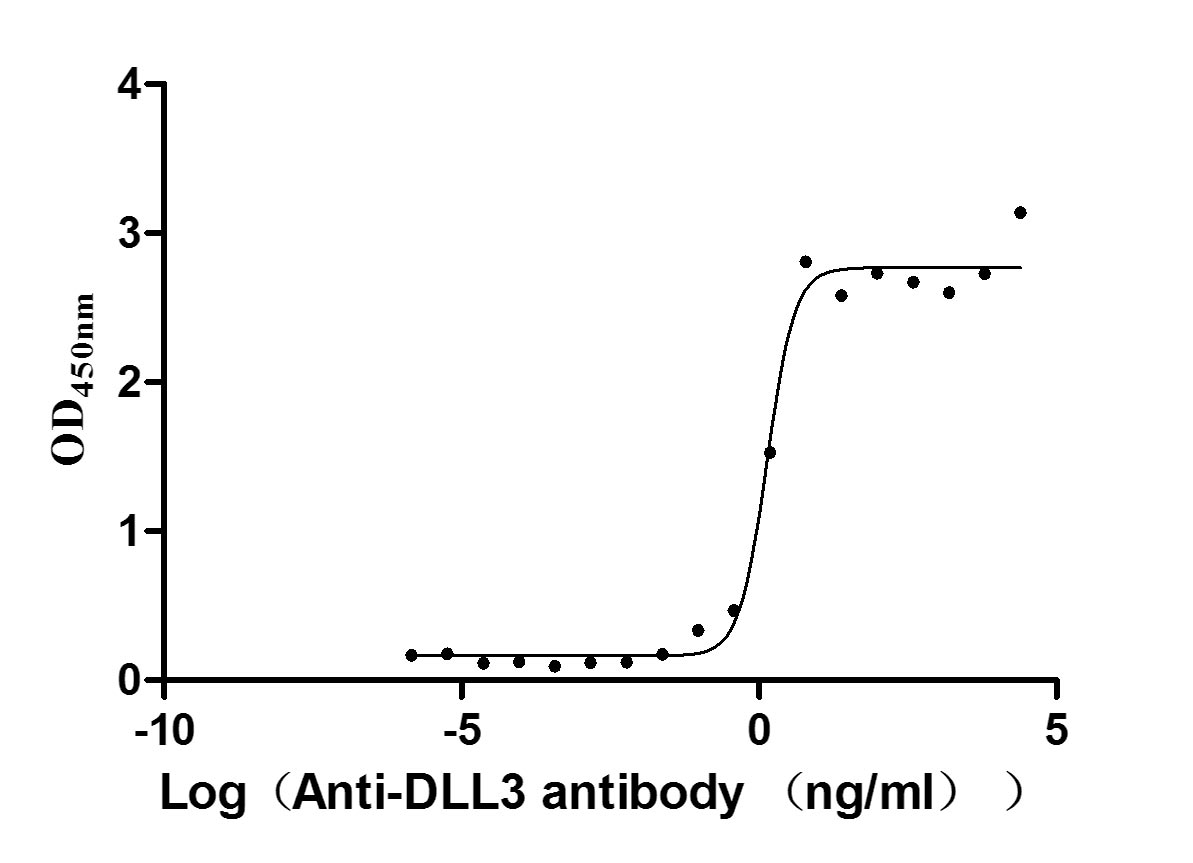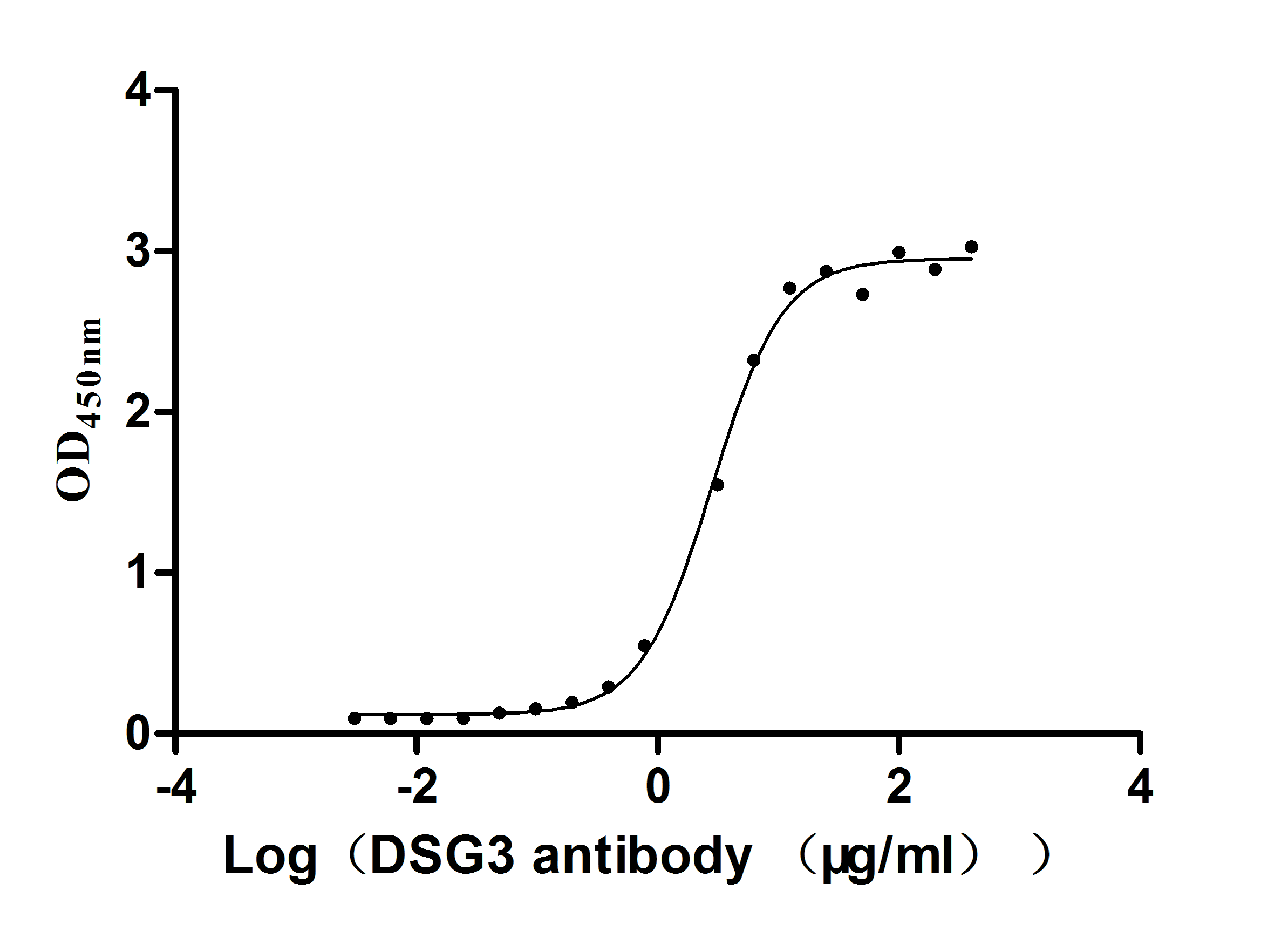Recombinant Mouse Toll-like receptor 5 (Tlr5), partial
-
货号:CSB-YP023604MO
-
规格:
-
来源:Yeast
-
其他:
-
货号:CSB-EP023604MO
-
规格:
-
来源:E.coli
-
其他:
-
货号:CSB-EP023604MO-B
-
规格:
-
来源:E.coli
-
共轭:Avi-tag Biotinylated
E. coli biotin ligase (BirA) is highly specific in covalently attaching biotin to the 15 amino acid AviTag peptide. This recombinant protein was biotinylated in vivo by AviTag-BirA technology, which method is BriA catalyzes amide linkage between the biotin and the specific lysine of the AviTag.
-
其他:
-
货号:CSB-BP023604MO
-
规格:
-
来源:Baculovirus
-
其他:
-
货号:CSB-MP023604MO
-
规格:
-
来源:Mammalian cell
-
其他:
产品详情
-
纯度:>85% (SDS-PAGE)
-
基因名:
-
Uniprot No.:
-
别名:Tlr5; Toll-like receptor 5
-
种属:Mus musculus (Mouse)
-
蛋白长度:Partial
-
蛋白标签:Tag type will be determined during the manufacturing process.
The tag type will be determined during production process. If you have specified tag type, please tell us and we will develop the specified tag preferentially. -
产品提供形式:Lyophilized powder
Note: We will preferentially ship the format that we have in stock, however, if you have any special requirement for the format, please remark your requirement when placing the order, we will prepare according to your demand. -
复溶:We recommend that this vial be briefly centrifuged prior to opening to bring the contents to the bottom. Please reconstitute protein in deionized sterile water to a concentration of 0.1-1.0 mg/mL.We recommend to add 5-50% of glycerol (final concentration) and aliquot for long-term storage at -20℃/-80℃. Our default final concentration of glycerol is 50%. Customers could use it as reference.
-
储存条件:Store at -20°C/-80°C upon receipt, aliquoting is necessary for mutiple use. Avoid repeated freeze-thaw cycles.
-
保质期:The shelf life is related to many factors, storage state, buffer ingredients, storage temperature and the stability of the protein itself.
Generally, the shelf life of liquid form is 6 months at -20°C/-80°C. The shelf life of lyophilized form is 12 months at -20°C/-80°C. -
货期:Delivery time may differ from different purchasing way or location, please kindly consult your local distributors for specific delivery time.Note: All of our proteins are default shipped with normal blue ice packs, if you request to ship with dry ice, please communicate with us in advance and extra fees will be charged.
-
注意事项:Repeated freezing and thawing is not recommended. Store working aliquots at 4°C for up to one week.
-
Datasheet :Please contact us to get it.
靶点详情
-
功能:Pattern recognition receptor (PRR) located on the cell surface that participates in the activation of innate immunity and inflammatory response. Recognizes small molecular motifs named pathogen-associated molecular pattern (PAMPs) expressed by pathogens and microbe-associated molecular patterns (MAMPs) usually expressed by resident microbiota. Upon ligand binding such as bacterial flagellins, recruits intracellular adapter proteins MYD88 and TRIF leading to NF-kappa-B activation, cytokine secretion and induction of the inflammatory response. Plays thereby an important role in the relationship between the intestinal epithelium and enteric microbes and contributes to the gut microbiota composition throughout life.
-
基因功能参考文献:
- hematopoietic TLR5 deficiency inhibits atherosclerotic lesion formation by attenuated macrophage accumulation and defective T-cell responsiveness. PMID: 28202909
- Denatured flagellin suppressed the production of the pro-inflammatory cytokines induced by intact flagellin or Pseudomonas aeruginosa both in vitro and in vivo, probably by blocking TLR5. PMID: 29589550
- Data show that Toll-like receptor 5 (TLR5) plays a role in radiation-induced apoptosis, and CBLB502 pre-treatment could reduce the apoptosis. PMID: 28407032
- These results suggest that HMGB1-modulated TLR5 signaling is responsible for pain hypersensitivity. PMID: 27760316
- data directly demonstrate that nasal epithelial GM-CSF contributes to TLR5-mediated modulation of airway DCs and a subsequent IgA response. PMID: 28522600
- Distinctive Recognition of Flagellin by Human and Mouse Toll-Like Receptor 5 PMID: 27391968
- The activation of NLRC4 by flagellin downregulated the flagellin-induced and TLR5-mediated immune responses against flagellin. PMID: 25914934
- TLR5 but not NLRC4 is required for S. pneumoniae FliC-induced protection. PMID: 27546231
- TLR5 mediates CD172a(+) intestinal lamina propria dendritic cell induction of Th17 cells. PMID: 26907705
- TLR5 activation plays an important role in the induction of podocyte apoptosis PMID: 26914743
- TLR5 gene knockout impairs some effects of weight-reduction in diet-induced obesity (DIO). The glucose intolerance in DIO TLR5(-/-) mice was more significant than that in DIO C57BL/6 mice. PMID: 26681840
- The results suggest that caveolin-1/TLR5 signaling plays a key role in age-associated innate immune responses and that FlaB-PspA stimulation of TLR5 may be a new strategy for a mucosal vaccine adjuvant against pneumococcal infection in the elderly. PMID: 26223660
- Over-activation of TLR5 signaling by high-dose flagellin induces liver injury in mice. PMID: 25418468
- results define systemically administered TLR5 agonists as organ-specific immunoadjuvants, enabling efficient antitumor vaccination that does not depend on identification of tumor-specific antigens PMID: 26831100
- an altered composition of the microbiota in a given environment can result in metabolic syndrome, but it is not a consequence of TLR5 deficiency per se PMID: 26950299
- aa 89-96 of flagellin is not only the crucial site responsible for TLR5 recognition, but is also important for humoral immune adjuvanticity through a TLR5-independent pathway. PMID: 25195514
- Gut inflammation in TLR5KO mice is dependent upon the presence of a gut microbiota. PMID: 26067589
- Tlr5 is co-expressed with neurofilament-200 in large-diameter A-fiber neurons in the dorsal root ganglion, skin nerve fibers, and spinal cord axonal terminals. PMID: 26479925
- These data show that TLR5 is a novel activator of RANKL and osteoclast formation and, therefore, a potential key factor in inflammation-induced bone erosions in diseases like RA, reactive arthritis, and periodontitis. PMID: 26207027
- gene deficiency results in an increase in susceptibility to invasive lung infection PMID: 25402425
- These results show that NLRC4 and TLR5, key components of two flagellin sensing pathways, each contribute to host defense in respiratory melioidosis. PMID: 25232720
- A new immunotherapeutic approach based on TLR5 activation and IFN-gamma production capable to control the metastatic growth of B16F10-Nex2 melanoma in mice. PMID: 25223833
- Data indicate that (131)I-radiolabelled anti-Toll-like receptor 5 (TLR5) monoclonal antibody (mAb) uptake in the grafts significantly correlated with TLR5 expression in the allograft area. PMID: 25283154
- TLR5 is important to limit myocardial damage, inflammation and functional compromise after myocardial ischemia-reperfusion. PMID: 25757463
- these findings indicate that the epithelial TLR5 participates in renal antibacterial defence, but paradoxically favours the translocation of Uropathogenic Escherichia coli across intact renal medullary collecting duct cell layers. PMID: 24779433
- Study demonstrates that TLR5 recognition of commensal microbiota regulates systemic tumor-promoting inflammation and, subsequently, extramucosal malignant progression. PMID: 25533336
- The results suggest a limited role for flagellin/TLR5 interactions in B. cereus endophthalmitis. PMID: 24959742
- Expression of TLR5 on intestinal epithelial cells regulates the composition and localization of the intestinal microbiota, preventing diseases associated with intestinal inflammation. PMID: 25172014
- these novel findings demonstrate that a direct and an indirect mechanism are involved in TLR5-driven rheumatoid arthritis inflammation and bone destruction. PMID: 25200955
- Airway structural cells regulate TLR5-mediated mucosal adjuvant activity. PMID: 24064672
- We discovered that TLR5, a cell surface receptor for bacterial protein flagellin, also requires UNC93B1 for plasma membrane localization and signaling. PMID: 24778236
- Data demonstrated that Notch1 synergistically increases TLR5mediated NF-kappaB activation. PMID: 24048326
- this study demonstrates IgG2c responses toward flagellin were TLR5 and inflammasome dependent; IgG1 was the dominant isotype and partially TLR5 and inflammasome dependent. PMID: 24442437
- These results indicate that polyethylenimine is a new TLR5 agonist with potential application in offering protection for patients receiving radiotherapy or in radiation-related accidents. PMID: 23104900
- These results suggest that cooperation of NOD and TLR receptors is important for effective responses to microbial infection in vivo. PMID: 23897616
- PTEN deletion impeded Mal localization at the plasma membrane and suppressed Mal-TLR5 interaction. These results suggest that, by controlling Mal recruitment, PTEN regulates TLR5-induced inflammatory responses. PMID: 23038756
- Cell surface expression of TLR5 is dependent on PRAT4A and restricted to neutrophils, classical monocytes and specific DC subsets. PMID: 22836022
- Both colitic and noncolitic TLR5-deficient mice exhibited transiently unstable microbiotas. PMID: 22863420
- a new beneficial effect of CBLB502, and suggests that TLR5-mediated immune modulation may be a promising approach to improve GVT immunity without exacerbating graft-versus-host disease. PMID: 23045613
- Mucosal dendritic cells (DCs), but not splenic DCs, express high levels of Tlr5 protein. PMID: 22545147
- TLR4 and TLR5 agonists lipopolysaccharide and flagellin, respectively, induced late degranulation mediated by TNF-alpha in Paneth cells. PMID: 21567398
- findings demonstrate that TLR5 engagement plays a major role in P. aeruginosa internalization and in triggering IL-1beta formation PMID: 22307620
- DUOX2 plays pivotal roles in TLR5-dependent inflammatory response of nasal airway epithelium. PMID: 21714724
- study found glucose up-regulates TLR-5 in islet cells, and that TLR-5 activation reduces insulin secretion, increases the level of heat-shock protein and increases MHC class I transport for presentation. PMID: 21985371
- study demonstrates that intestinal epithelia, despite not expressing IL-1beta, secrete sIL-1Ra in a TLR5-dependent manner suggesting that loss of TLR5 may promote inflammation by increasing IL-1beta activity PMID: 20844479
- We document a novel role for TLR5 in the rapid targeting of flagellin by intestinal pathogen-specific CD4 T cells PMID: 21451112
- TLR5 stimulation significantly improves pathological changes in the cecum and colon of Clostridium difficile-infected mice and reduces epithelial cell loss. PMID: 21245274
- An Myd88-independent function was uncovered for dendritic cell TLR5 in enhancing the presentation of peptides to flagellin-specific CD4+ T cells. PMID: 21182074
- the p110alpha and beta isoforms of class IA PI3K are both required for the proinflammatory response to flagellin via TLR5 PMID: 20953381
- TRIF deficiency inhibits TLR5-induced signaling in mouse intestinal epithelial cells. PMID: 20855887
显示更多
收起更多
-
亚细胞定位:Membrane; Single-pass type I membrane protein.
-
蛋白家族:Toll-like receptor family
-
组织特异性:Highly expressed in liver. Detected in lung and at very low levels in most other tissues.
-
数据库链接:
KEGG: mmu:53791
STRING: 10090.ENSMUSP00000106625
UniGene: Mm.116894
Most popular with customers
-
Recombinant Human Tumor necrosis factor receptor superfamily member 18 (TNFRSF18), partial (Active)
Express system: Mammalian cell
Species: Homo sapiens (Human)
-
Recombinant Human Mucin-16 (MUC16), partial (Active)
Express system: Mammalian cell
Species: Homo sapiens (Human)
-
Recombinant Human Delta-like protein 3 (DLL3), partial (Active)
Express system: Mammalian cell
Species: Homo sapiens (Human)
-
Recombinant Mouse Desmoglein-3 (Dsg3), partial (Active)
Express system: Mammalian cell
Species: Mus musculus (Mouse)
-
Recombinant Human Signal transducer CD24 (CD24)-Nanoparticle (Active)
Express system: Mammalian cell
Species: Homo sapiens (Human)
-
Recombinant Human Trophoblast glycoprotein (TPBG), partial (Active)
Express system: Mammalian cell
Species: Homo sapiens (Human)
-
Recombinant Human Claudin-6 (CLDN6)-VLPs, Fluorescent (Active)
Express system: Mammalian cell
Species: Homo sapiens (Human)
-
Recombinant Human Gastric inhibitory polypeptide receptor(GIPR),partial (Active)
Express system: Mammalian cell
Species: Homo sapiens (Human)








f4-AC1.jpg)











